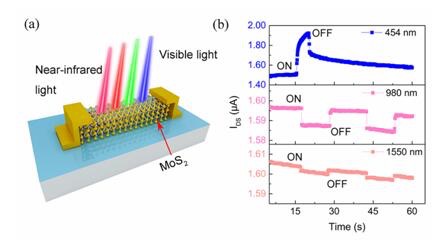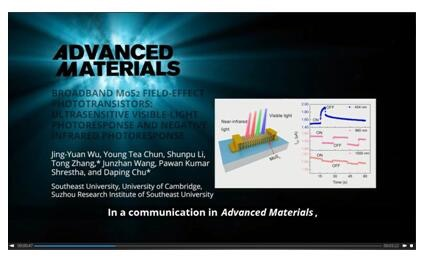
Light makes the whole world colorful. A photodetector is a device that converts light into an electrical signal that is easy for people to recognize. The human eye is a natural photodetector. The visible light range of the human eye is usually between 380 and 780 nanometers. Infrared light with a wavelength greater than 780 nm is an "invisible light" that human eyes cannot recognize and recognize. However, infrared light plays an extremely important role in the fields of electronic communication, security monitoring, biomedical, military and aerospace. Recently, the team of Professor Zhang Tong of the "oint International Research Laboratory of Information Display and Visualization" of Southeast University collaborated with Professor Daping Chu of the University of Cambridge in the UK to propose a new photodetector based on a new two-dimensional material molybdenum disulfide. Infrared light detection that breaks through the band gap of molybdenum disulfide. The results of the study were published in the "High-Spectrum Response Molybdenum Oxide Field Effect Phototransistor: Ultrasensitive Visible Light Response and Infrared Negative Response" in Advanced Materials (“Advanced Materials” Impact Factor 19.791).

In this study, they used the novel two-dimensional material molybdenum disulfide peculiar optoelectronic properties to observe the positive response of the ultrasensitive photocurrent to visible light and the rapid negative response to infrared light in the same device. This means that while obtaining highly sensitive visible light detection, the detector can further expand the range of light response to the infrared band that the human eye cannot observe, just like another pair of human eyes. This invention has changed the traditional concept that "Photonic visible detectors can not be used for infrared detection due to bandgap limitation”, which provides a new perspective for the research of nanophotodetectors. At the same time, due to its simple structure, low production cost and good repeatability, this detector is very suitable for industrialization. It is expected to be widely used in military and civilian fields in the near future.

It is worth mentioning that the first author of the team is a young "post-90s" Ph.D., Wu Jingyuan, a doctoral student at the School of Electronic Science and Engineering at Southeast University. As early as the fall of 2012, Professor Zhang Tong visited the University of Cambridge. In an unintentional conversation with a colleague, he discussed the prospect of using a new two-dimensional material, molybdenum disulfide, as a photoelectric detector. On the same day, Professor Zhang Tong was excited to call back to China to arrange for graduate students to conduct relevant research. Wu Jingyuan, who had just entered the school that year, was one of the first students to contact molybdenum disulfide research.
In order to obtain more scientific research progress, in 2015, recommended by the instructor Professor Zhang Tong, Wu Jingyuan went to the Photonics and Electronics Center of the Department of Engineering, Cambridge University, and studied under Professor Daping Chu, Chairman of the Advanced Optoelectronics and Electronics Research Center of the Department of Engineering. Here, she started the preparation experiment based on molybdenum disulfide transistor with the expectation of Professor Zhang Tong. However, the road to scientific research has never been “smooth”. Due to the cumbersome process of preparing transistor devices, there are several steps including mechanically stripping two-dimensional materials, lithographic electrode patterns, vapor-deposited metal electrodes, and photoresist stripping. The complete preparation process of a device usually takes a whole day, and each step has a slight difference, which will result in poor detector performance and affect the experimental results. In the key step of "lithography", the general device size is large, and only a few seconds of debugging can be directly aligned. The mechanically stripped molybdenum disulfide has a width of only a few microns, and it is necessary to precisely align two electrodes of several tens of micrometers and 5 micrometers apart on both sides of the two-dimensional material by means of a microscope. This must be done manually, and the operator needs patience and care. For the novice, such an alignment process takes more than half an hour, and many Cambridge colleagues have said that they want to give up. For Wu Jingyuan, who is scrambling to explore scientific research results, she never thought about the word "abandon". The so-called "practice makes perfect", after hundreds of experiments in a few months, her lithography operation is very skilled, aiming at a sample for no more than five minutes. Once, when she was doing a good job of experimenting, she suddenly heard the alarm ringing and went to the corridor to find that the smoke was rolling. It turned out that there was a fire in the laboratory next door. She rushed out with her classmates, and even the experimental super clean clothes did not have time to take off, but the brain was thinking that half of the samples were still in the laboratory.
In the summer of 2016, Wu Jingyuan got some gratifying experimental results. Their devices have two orders of magnitude higher visible light sensitivity than existing devices and can be used for weak optical signal detection. When she was struggling with the uncertainty of the next research direction, Professor Zhang Tong came to Cambridge again. In the office of Prof. Chu, three people conducted in-depth discussions. Professor Zhang Tong proposed to detect infrared light based on the highly sensitive detection performance of molybdenum disulfide detectors for visible light. At the end of the one-year visit, Wu Jingyuan applied for an extension of four months and continued to complete the research of the detector. According to the prior literature, molybdenum disulfide based detectors are generally used for visible light detection. Since molybdenum disulfide is very weak in light absorption after 800 nm wavelength, it is generally considered that the molybdenum disulfide photodetector has a weak response to infrared light and cannot even respond to light of 1033 nm wavelength. However, when Wu Jingyuan first tried to illuminate the detector with 980 nm light, she found that the device had a clear response and exhibited an anomalous phenomenon of negative photocurrent. After excluding the test instrument interference problem and testing multiple devices, they began to analyze the physical mechanism of this anomaly. By conducting a low-temperature electrical test, they found that the conductivity of molybdenum disulfide decreased with increasing temperature, which was just enough to confirm the cause of the negative current response caused by infrared light. The same negative photocurrent response behavior was observed as they continued to increase the source wavelength to 1550 nm, which confirms their prediction that molybdenum disulfide visible light detectors can break through the band gap limit for infrared light detection!
Since 2010, Professor Zhang Wei has hosted more than ten national key projects such as the National Key R&D Program of the Ministry of Science and Technology and the “Major” Project of the General Armament Department, and has achieved a series of remarkable scientific research results. He has published more than 80 papers in SCI journals, compiled 1 part of optoelectronic technology books and 3 related translations of micro-nanophotonics, applied for more than 50 invention patents in China, and obtained nearly 30 invention patents in China. Authorized 4 US invention patents, 1 international PCT patent... The invention of molybdenum disulfide detectors has become another breakthrough achievement of the team in the field of optoelectronic devices.
"Don't be afraid of hardships, not forgetting the original heart" is Professor Zhang Wei's request for the team. It is the "motto" that they continue to surpass and move forward. It is also the "power source" for the team to win fruitful academic achievements and lead the field of nano-optics.
